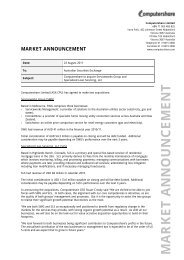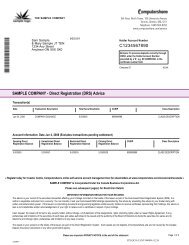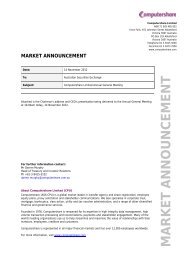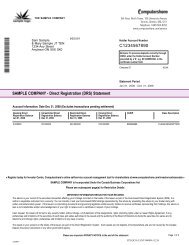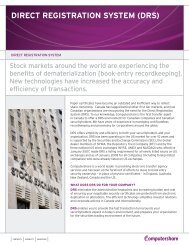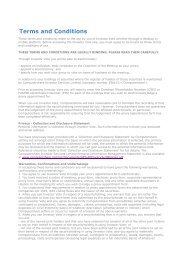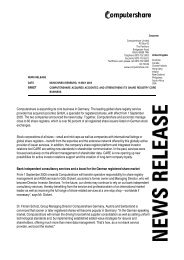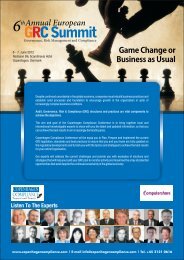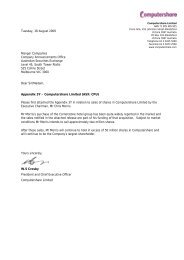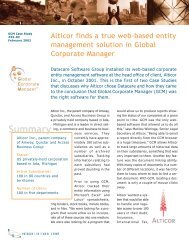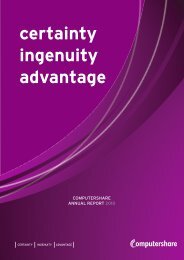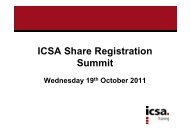COMPUTERSHARE ANNUAL REPORT 2008
COMPUTERSHARE ANNUAL REPORT 2008
COMPUTERSHARE ANNUAL REPORT 2008
You also want an ePaper? Increase the reach of your titles
YUMPU automatically turns print PDFs into web optimized ePapers that Google loves.
Notes to the Financial StatementsNon-current assets (or disposal groups) held for saleNon-current assets and liabilities (or disposal groups) classified as held for sale are presented separately from other assets andliabilities in the balance sheet. They are stated at the lower of their carrying amount and fair value less costs to sell if their carryingamount will be recovered principally through a sale transaction rather than through continuing use.An impairment loss is recognised for any initial or subsequent write down of the asset (or disposal group) to fair value less coststo sell. Non-current assets are not depreciated or amortised while they are classified as held for sale. Interest and other expensesattributable to the liabilities of a disposal group classified as held for sale continue to be recognised.Share capitalOrdinary share capital bears no special terms or conditions affecting income or capital entitlements of the shareholders andis classified as equity. Costs directly attributable to the issue of new shares are shown in equity as a deduction, net of tax, fromthe proceeds.Investments and other financial assetsThe Group classifies its investments and other financial instruments in the following categories: financial assets at fair valuethrough profit or loss, loans and receivables and available for sale assets. The classification depends on the purpose for which theinvestments were acquired. Management determines the classification of its investments at initial recognition and re-evaluates thisdesignation at each reporting date.i. Financial assets at fair value through profit or lossThis category has two sub categories: financial assets held for trading and those designated at fair value through profit or loss oninitial recognition. A financial asset is classified in this category if acquired principally for the purpose of selling in the short term orif so designated by management.ii. Loans and receivablesLoans and receivables are non derivative financial assets with fixed or determinable payments that are not quoted in an activemarket. They are included in current assets, except for those with maturities greater than 12 months after the balance sheet datewhich are classified as non-current assets. Loans and receivables are included within receivables in the balance sheet.iii. Available for sale assetsAvailable for sale financial assets are non-derivatives that are either designated in this category or not classified in any of the othercategories. They are included in non-current assets unless management intends to dispose of the investment within 12 months ofthe balance sheet date.Initial recognition and subsequent measurementAll financial assets are initially recognised at fair value plus transaction costs. Loans and receivables are subsequently carried atamortised cost using the effective interest method. Subsequently, available for sale financial assets and financial assets at fair valuethrough profit or loss are carried at fair value. Realised and unrealised gains and losses arising from changes in fair value of financialassets at fair value through profit or loss category are included in the income statement in the period in which they arise. Unrealisedgains and losses for changes in fair value of available for sale assets are recognised in equity in the available for sale asset reserve.When these assets are sold or impaired, the accumulated fair value adjustments are included in the income statement.The fair values of quoted investments (classified as available for sale assets or held for trading assets) are based on current bidprices. If the market for a financial asset is not active (and for unlisted securities), the Group establishes the fair value by usingaccepted valuation techniques.The Group assesses at each balance date whether there is objective evidence that a financial asset or group of financial assetsis impaired.BorrowingsBorrowings are initially recognised at fair value. Borrowings are subsequently measured at amortised cost. Any difference betweenthe proceeds and the redemption amount is recognised in the income statement over the period of the borrowing using theeffective interest method. Borrowings are classified as current liabilities unless the Group has a legal right to defer settlement of theliability for at least 12 months after the balance sheet date.Derivative InstrumentsThe Group uses derivative financial instruments to manage specifically identified interest rate and foreign currency risks.Derivatives are initially recognised at fair value on the date a derivative contract is entered into and are subsequently re-measuredto their fair value. The method of recognising the resulting gain or loss depends on whether the derivative is designated as ahedging instrument, and if so, the nature of the item being hedged. The Group designates certain financial instruments, includingderivatives, as either; (1) hedges of net investments of a foreign operation; (2) hedges of firm commitments (cash flow hedges); or(3) fair value hedges.PAGE 46 Computershare Annual Report <strong>2008</strong>



